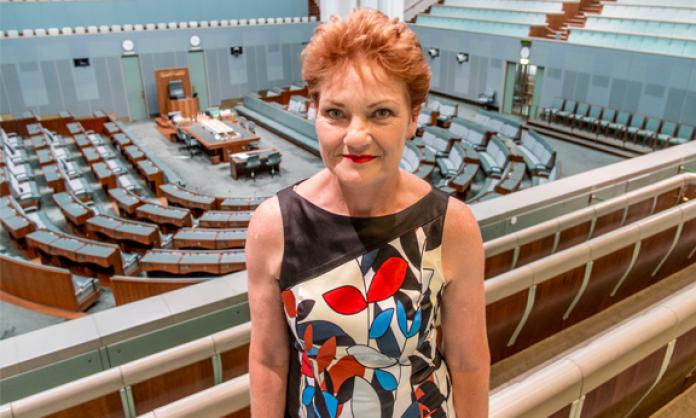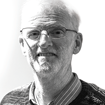Commentators continue to fall over each other arguing why we all should not be nasty to poor dear Pauline Hanson. Former Liberal staffer Tom Switzer’s opinion piece “Beware a media martyr” in the Fairfax press on 5 September is a prize case study of this appalling trend.
His argument for pandering to Hanson rests on an absolute misrepresentation of the political and media response to her last time around. According to Switzer, Hanson “was immediately given the pariah treatment” after her racist maiden speech in parliament on 10 September 1996:
“Twenty years ago it would have been career death for mainstream politicians to reach out to Hanson … the prevailing wisdom among the media-political class was that John Howard should demonise Hanson – or at least attack her in forthright terms.
“If anything, the abusive demonstrations and media clamour attracted attention to Hanson and helped raised her profile. But Howard’s refusal to follow the media script meant One Nation failed to leave an imprint on the political landscape.”
None of this is true except for the statement that Howard refused to attack Hanson.
Hanson was in no sense isolated among the Liberals and Nationals in her first two years in parliament. After her maiden speech, numerous government members rushed to congratulate her.
Coalition MPs such as Bob Burgess rivalled Hanson in their extreme racist positions at this time. Liberal senator Ross Lightfoot attacked Aborigines as the lowest race on earth.
Howard praised Hanson for breaking the fetters of “political correctness”. The National Party asked her to speak at its branch meetings, and she was subsequently given a standing ovation at a Bribie Island Nationals women’s branch meeting.
A number of people who joined Hanson’s One Nation came from the Nationals or the Liberals, including operatives such as David Ettridge. A poll in late 1996 showed that 72 percent of Coalition voters agreed with Hanson.
In mid-1998, the Liberals preferenced Hanson in the Queensland state election, enabling One Nation to win a swag of seats.
Hanson had been elected in March 1996, but it wasn’t until September, when she made her maiden speech, that she became a sensation. Far from treating her as a “pariah”, the media gave her celebrity status with wall to wall largely positive coverage.
In an unprecedented development, Hanson’s speech was published in full in all the papers. The TV hosts lapped her up.
In the previous six months, the Liberals and the Nationals had opened the racist floodgates after their election victory. This prepared the ground for Hanson.
It is important to remember how ballistic and hysterical Howard and Co. were in attacking Aborigines. The central issue was land rights and native title. Aborigines were supposedly about to steal our backyards and drive us all back to the Stone Age.
Deputy PM Tim Fischer crowed that he would deliver “bucket loads of extinguishment” of native title claims.
Howard also went on a relentless offensive against the “black armband” view of Australian history and the “Aboriginal industry”. He launched strident attacks on ATSIC (the Aboriginal and Torres Strait Islander Commission) and the Aboriginal Legal Services, cutting their funding and eventually abolishing ATSIC altogether. He refused to apologise to the Stolen Generations and cut Abstudy.
As well as attacking Aborigines, it is usually stated that Hanson concentrated her attacks on Asians. That is a little misleading. It was an across the board attack on migration, though of course the attacks on Asians were an important part of it.
Again, the Liberals were leading the charge well before Hanson arrived. Howard campaigned in the lead-up to the 1996 election with a pledge to cut migration – which the Liberals blamed for unemployment. By June 1997, migration had been cut by 20 percent. Indeed, Howard attacked Hanson from the right on immigration, claiming he was “tougher” on the question.
The Liberals cut welfare for migrants, attacked so-called ethnic lobbies, made it harder for people who didn’t speak English to immigrate, abolished the Bureau of Immigration, Multicultural and Population Research and introduced new regulations to deport so-called migrant criminals. Immigration minister Ruddock denounced the “Rolls Royce treatment” of refugees.
All of this was justified in the racist code language of representing “mainstream” Australia.
You tend to forget the scale of the attacks on migrants in those years. They were being scapegoated for all the ills of capitalism – unemployment, environmental destruction, long hospital waiting lists, housing prices and lack of adequate infrastructure.
The Australian Democrats, which were still a significant electoral force, had a zero net migration policy. So too did the emerging Greens. Numerous environmentalists were anti-immigration. Anti-immigration academics like Monash University’s Bob Birrell were given lots of media coverage.
The more explicit anti-Asian element was taken up by the likes of prominent historian Geoffrey Blainey and radio shock jock Alan Jones.
The culture wars were at their height. All the stuff about “freedom of (racist) speech” was more alive than it is today. It was the prime minister who was pushing it, not just backbenchers.
But it wasn’t only the Liberals who refused to take on Hanson when she burst on the scene. Labor leader Kim Beazley remained mute. Beazley had form. Hanson was not the only hard right racist independent elected in March 1996. The other one was Graeme Campbell, the Labor MP from Kalgoorlie, 1980-98. For years, Beazley had defended Campbell, who was very close to the fascist League of Rights.
So in no sense was Hanson isolated or shunned in parliament in 1996. She was very much swimming with the racist stream.
After the 1998 Queensland state elections, when Hanson emerged as a serious electoral threat to the Liberals, a harder line was taken against her organisation – but not against her racist ideas. Howard went out of his way to co-opt most of them.
So it is far from being the case that Howard’s refusal to take on Hanson meant, as Switzer alleges, “One Nation failed to leave an imprint on the political landscape”. Howard and Hanson effectively operated as a tag team that pushed the whole framework of Australian politics to the right.
Nor is it the case that “abusive demonstrations … helped raise her profile”. She had obtained celebrity status well before there were any demonstrations. The saturation media coverage of her maiden speech in September ensured that. And the coverage did not let up.
The first demonstration of any size against Hanson did not occur until November 1996. And it was not until well into 1997 that there started to be confrontational demonstrations that shut down One Nation party meetings.
Those militant demonstrations, which continued well into 1998, began to turn the tide against Hanson.









